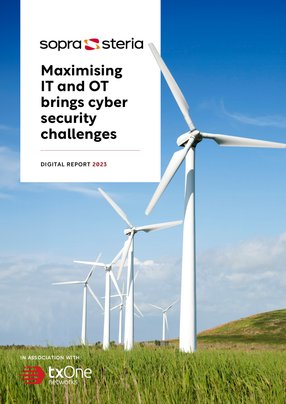Maximising IT and OT brings cyber security challenges
Industries are evolving at a range of change that is unseen in history. Digital technology is the ultimate differentiator between operations that survive versus those that thrive, and deliver new efficiencies to meet company demands.
The questions that industries face today are about the future and how systems can work together more effectively to transform operations. This opens up new conversations about security. With technology taking the wheel as companies digitise and digitalise with operational technologies (OT), cybersecurity becomes an imminent challenge to businesses and their supply chains as without proper care, they risk significant downtime and damage to their commercial outcomes.
In order to help companies stay ahead of the curve, one of Europe’s largest digital transformation consultancies Sopra Steria is driving the conversation in this area with technology and sustainability at the core of its business.
As explained by the company’s Director of Industrial IT, OT & Cybersecurity, Kenneth Titlestad, the organisation is committing to advising its partners on how best to move forward in the digital era.
“We focus on providing the best advice to—and being partners with—our clients, so that they can get good effects out of their transformation journeys. We also keep a really high focus on providing value to not only the clients, but also to society. That's something that has strengthened over the five years I've been with the company, the focus on sustainability,” says Titlestad.
“We've also been strengthening our focus on the technology side as well—with the focus nowadays on the sustainability side of technology, instead of just technology for technology. I often discuss, not just Industry 4.0, but Industry 5.0. It requires much more consideration on the sustainability side of things.”
Sopra Steria is driven by three key statements that are the pinnacle of its core value system. These include ‘Shape the future’, ‘Provide value to our customers’ and ‘The power of sharing’. These three values sum up what the consultancy is really about—understanding the needs of clients and sharing the relevant knowledge with them to deliver on their goals.
Much of the company's work, as alluded to before, is centred around the industry revolution and evolving technologies coming as a result of years of research and innovation.
“The pace of evolution or what they call the Fourth Industrial Revolution is a big challenge for companies. There's a lot of new technology seeing the daylight nowadays with drones, robots, autonomous systems — lots of research and developments going on,” says Titlestad.
“Finding the right combination of these kinds of technologies, the companies can have a really strong foothold in business and become more competitive in the market. Looking from the outside we see them stressing over the licences to operate. They need to find the sweet spot with technology and we see a lot of the technology nowadays is experimental—it's not working just as it should or the way they expected.”
It’s in this area where companies can effectively be left behind if they are unable to get up to speed with the latest digital trends.
“When experimental technology is combined, the effects are not easy to predict. Still, we are reminded of what Klaus Schwab from World Economic Forum said some years ago, that ‘In the new world, it is not the big fish which eats the small fish, it's the fast fish which eats the slow fish, it's the fast who will get the future benefits’. You are giving yourself a difficult task, because moving fast in this rapidly evolving technological area is really difficult,” Titlestad explains.
Cybersecurity is a product of OT digital transformation
When it comes to cybersecurity, what are organisations dealing with as they evolve digitally?
“With a mature level of digital twin, you can provide rich data streams to your vendors that know how to prescriptively and precisely maintain their and your equipment. Then you have the whole value chain working together as an orchestra so that we can actually get the best benefits from our industry,” says Titlestad.
“But, that's on the Industry 4.0 side, it's a lot about technology and, of course, products and interoperability. But in terms of Industry 5.0, the focus is shifted more to the sustainability of things, and the total outcome for humans. They say that Industry 5.0 is humanity’s revenge over Industry 4.0.”
Titlestad identifies some of the stakes when shifting from Industry 4.0 to Industry 5.0 from a cybersecurity perspective, which has become a major threat to businesses—particularly when OT is plugged in, theoretically, to the digital ecosystem. Although criminal activity, such as theft, fraud and sabotage, is the same as any, much of it now appears in the digital world.
“What we’ve seen in recent years is also espionage, terrorism and war from a digital perspective. All of these digital technologies we implement around us are being exploited for fraud, sabotage, vandalism, terrorism and also being used as tools for war,” says Titlestad.
“The tools and critical infrastructure systems need to be resilient and robust enough to withstand everything from just pure daily vandalism and break-downs all the way to cyber warfare.”
Dependence on the cloud means relying on the internet
Also highlighted in this conversation is a point about the use of data lakes and the cloud, which can leave organisations prone to attack from a different angle. The internet being a staple in today’s digital society makes it a hot target for acts of crime, sabotage and terrorism, leaving organisations vulnerable if they operate solely on the cloud. What this means, Titlestad explains, is that organisations shouldn’t be fully dependent on data lakes accessed via different countries.
“If you lose the internet connection or if we go into a more unstable geopolitical situation where attacks attempt to actually take down your internet connections, then you shouldn't rely on big data or data lakes outside of your country. That could be a really big vulnerability on big data on the internet,” says Titlestad.
A further risk he notes is the competency squeeze—referring also to the generational gap in digital capabilities, which is something to be considered as technologies evolve and individuals struggle to keep up.
“We see that there's a really big need to get more people to have competency on new technology—technology by default—but there's just not enough people with all the technology coming in,” says Titlestad.
He continues: “Competency squeeze is a mega trend with the world's population getting older and older, and lots of new technology coming in. We see a need for more people to be competent with new technology and technology by default, but there's just not enough people with all the technology coming in. We get fewer and fewer available professionals to manage technology. So, we have a lot of demand for competent people with technology in itself and even more so on Operations Technology and cybersecurity—huge competency squeeze,” says Titlestad.
So, Sopra Steria is responsible for some critical stages of cybersecurity in IT and OT, but how does it ensure that it can deliver the best possible insights and requirements to its clients?
Having worked with TXOne, it partners with the company as a product and service provider, but more importantly, it means that Sopra Steria can validate its approach through collaboration — aligned to the same goals of providing customers with what they need. Having seen the limited range of OT protection-based products on the market, TXOne delivers a keenness and sharp focus on the core demands of its technologies, making it a valuable partner for the business.
“A lot of companies or producers come from IT and they try to change their products or modify them so they can work within OT as well. TXOne is a company which is dedicated to OT, so that’s their main priority and that’s crucial in our partnership we have with them,” says Titlestad.
He also recognises broad partnerships as an important factor as a digital technology consultancy, gaining great insight into the available solutions in the market. Building a collaborative relationship with TXOne and others is part of Sopra Steria’s aim to keep up with the trends.
These organisations and partnerships will likely tackle the future together as Titlestad coupons up about Sopra Steria’s strategy, which is predominantly focussed on increasing its portfolio of clients and projects and providing further experience-based support to increasingly digital organisations.
“We are starting to see the mountain of regulations coming. So with the EU having implemented the NIS Directive, there's the Cyber Resilience Act, lots of regulations coming. Also, with AI suddenly coming all over the news, that’s an area that needs regulation,” Titlestad closes.
“That's something that we will need to navigate going forward. And assist our clients on how they can do the same. We saw that there was a tremendous pickup in the security area with the Russia-Ukraine situation. We also see the mega trends coming or being visible with, for instance, the population getting older. We see a huge need for optimising healthcare, a challenge that calls for even more comprehensive solutions. While various methods are essential, there is a particular emphasis on the pivotal role of digital technology in addressing these needs.”





